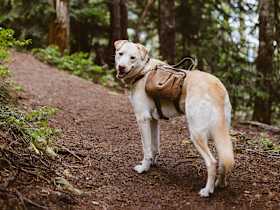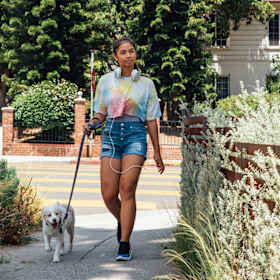Shelter Dogs: How to Adopt a Dog From a Shelter
Wondering where to go to rescue a pup, and what to do once they’re home? We’ve got all the answers.
Wondering where to go to rescue a pup, and what to do once they’re home? We’ve got all the answers.
by Kelly Villa, | April 15, 2024

Giada Canu / Stocksy
Adopting a shelter dog is an incredibly rewarding opportunity to provide a loving home for a dog in need, while helping combat pet overpopulation. To find the perfect shelter dog, it’s critical to research animal shelters, understand the adoption process, and take the time to actually meet dogs to find the right match for you.
There are many options for finding your new family member, from searching online networks like Adopt a Pet to connecting directly with shelters.
We turn to the internet to find most things these days, and looking for a pet is no exception. Adopt a Pet is an online resource that draws from local animal shelters, humane societies, and pet-rescue organizations to find available pups in your area. Through Adopt a Pet, you can customize your search by adding your preferred location, age, and breed. Once you enter your search, Adopt a Pet serves up a list of pet profiles that match your criteria.
In addition to this comprehensive resource, you can check out other reputable resources, as well as shelters and rescue organizations’ websites and social-media presences, to learn more about their work and available pets.
To select a shelter to visit, do a little research about the organizations in your area. You may want to go to a traditional shelter or an ASPCA or a humane society. No matter what kind of organization you visit, it’s important to choose a reputable one: You don’t want to support an organization that is only looking to profit, and doesn’t properly care for their animals.
Once you decide which facility to visit, bring your entire family with you to spend plenty of time with a desired pet outside of their kennel — in an adoption office, play yard, or even a hallway or lobby. Keep in mind that shelters are stressful environments for most dogs, and each dog will react differently. So you may not get an accurate sense of their true personality in this environment.
A great way to meet an adoptable pet is outside of the shelter. Many rescue organizations and shelters hold local adoption events at venues (such as supportive businesses) or other public places. To find out if your local shelter or rescue organization is holding an adoption event near you, check out their website and social media presence, or give them a call.
When adopting from a shelter or rescue organization, one of the first things you’ll need to do is fill out an application. Every organization’s application process is a little different, but they all share the purpose of making sure you find a pet who is right for you and vice versa. Most of the application questions will relate to learning more about you and your ability to provide a safe environment, plenty of love, and necessary care.
Most rescue organizations and shelters charge pet adoption fees to help cover the cost of rescuing and caring for the pets. For example, some rescues pay to transport pets from one part of the country to another — generally from crowded, high-kill shelters to another area where a pet has a better chance of finding a home. Shelters with facilities also need to pay their staff, which cares for the animals and shelter operations. The typical adoption fee is between $50 and $350, but many shelters and rescue organizations offer discounted fees, or may even waive fees, for certain pets or during certain times of the year.
After you fill out an application, a representative from the rescue or shelter will likely visit your house or apartment to make sure your home and lifestyle are suitable for a pet. Be prepared to answer questions such as, “Why do you want to adopt a dog?” and “Have you had experience with dogs before?”
When meeting a potential pet for the first time, it’s important to ask shelter or rescue staff for permission to approach them. If given permission, try to remain calm and confident, get down on the dog’s level, and let them sniff you. Pay attention to their body language. If their ears are back and their tail is tucked between their legs, for instance, they’re signaling that they’re uncomfortable. So it’s best to give them space. Pro tip: Treats always go a long way in winning over a new dog, so bring some with you and offer them to each pet if the shelter or rescue staff says it’s okay to do so.
When adopting a dog, you’ll want to get as much information about them as possible. It’s a good idea to ask the shelter or rescue staff the following questions:
How did the dog end up at the shelter or rescue?
Is the dog house-trained?
What is their temperament like (energetic or laid-back)?
Are they good with other dogs and/or kids?
Do they have any known behavioral issues?
Does the dog have any known medical conditions or dietary needs?
How much exercise does the dog need?
You will also want to ask yourself some questions, including: Are my lifestyle and living situation good fits for a dog? Can I afford a pet? Is everyone in my household on board with a new pet? Am I ready for a dog?
If you are bringing your new friend into a household with a resident pet, make sure to introduce the two on neutral ground. Try going for a walk, but do not walk the dogs nose to nose. A side-by-side walk will encourage companionship and tire them out.
Begin obedience classes and have the whole family participate. Learn to shape desirable behavior through positive reinforcement, rather than punish undesirable behavior. Obedience training has a settling effect on a dog and gives you the opportunity to bond. Take time to touch your new dog on their feet, ears, teeth, tail, and paws, because doing so will make trips to the groomer and veterinarian easier for everyone.
Remember to dog-proof your home (especially if you’re bringing home a puppy). Walk around your house and yard, moving anything you do not want the dog to get a hold of. If you do not want your new dog in certain rooms of the house, purchase baby gates to restrict access. Remember, it is your responsibility to keep your dog away from things you do not want destroyed or that might be harmful to them.
If you decide to crate-train your dog, purchase a crate that is just large enough for the dog to stand up and turn around in — no more, no less. If you are buying a crate for your puppy to grow into, you can block off a part of it. Stainless steel water and food bowls are recommended, since they cannot be chewed on and ingested. Also, be sure to look out for durable bedding that is hard to chew on and easy to clean. This will make your life much easier.
You will want to purchase a simple, four to six foot nylon leash with a collar. No flexi-leads, harnesses, or pinch collars will be necessary with proper training. You’ll want some toys as well. Get a nice variety, and rotate them every month so your dog doesn’t get bored. Hard, rubber toys are wonderful for dogs who chew, especially those that can be stuffed with anything from peanut butter and cream cheese to wet food and bananas. You can freeze them to keep your pooch busy for a longer period of time.
Feed your dog at the same times each day. As long as they are healthy, they’ll eat when hungry. (If your dog refuses to eat anything for a day, check with your vet.) Do not leave food out for longer than 20 minutes. Refrain from free-feeding, or leaving food out at all times. This can lead to obesity and makes it difficult for you to monitor your dog’s eating habits.
Even if your pup is healthy, make a vet appointment for your new dog about two weeks after they’ve joined your household.
Make sure the entire family understands the rules you’re setting for your dog, and that there is a clear consensus on which behaviors you’ll reinforce and which ones you will not.
If you’re not ready to adopt, fostering a dog (or caring for a dog while they wait to be adopted) is a great option. To learn more, reach out to your local shelter or foster-based rescue organization.
Adopting a shelter dog saves their life. More than six million dogs and cats enter US shelters each year. This has resulted in an overcrowding issue that is all-too-often resolved through euthanasia — 920,000 shelter animals are euthanized annually.
International Dog Adoptions: Get the Facts

Kelly Villa is a freelance writer and contributor to various pet publications.

Breed Info

Adoption Advice

Adoption Advice

Breed Info
Want a dog who sticks to you like glue? We’ve got just the breeds for you. Below, our shortlist of some of the most adoring canine breeds.

Adoption Advice
Are you finalizing a new pet’s adoption? Learn everything you need to know about pet adoption paperwork.

Adoption Advice
The beginning of puppy parenthood can be rough, but it does get better — especially when you implement this advice.

Shelters & Rescue

Adoption Advice

Adoption Advice
Is the responsibility of taking care of your pet causing you to worry about your budget? Rest assured, there are a number of ways to minimize this financial stress.